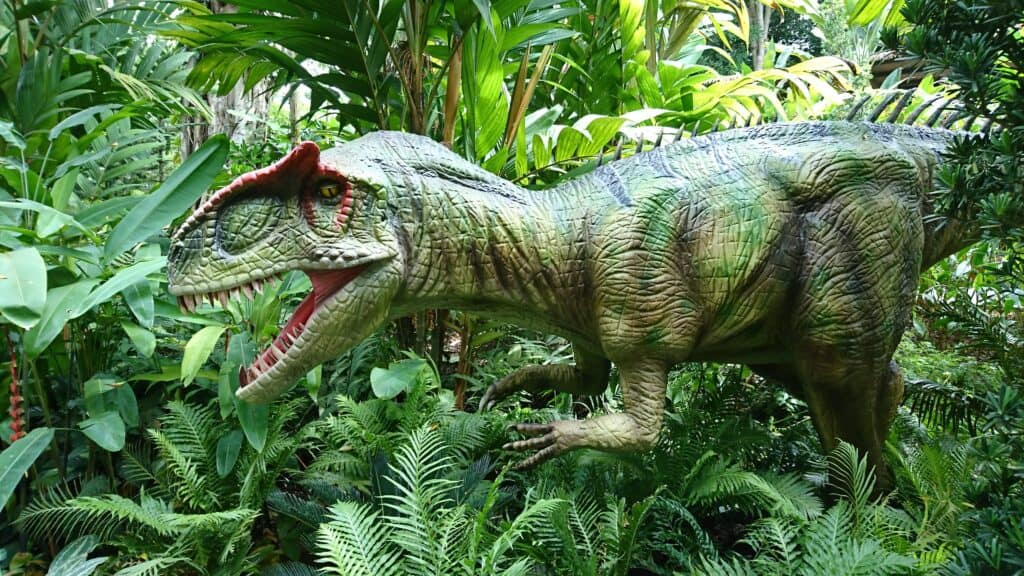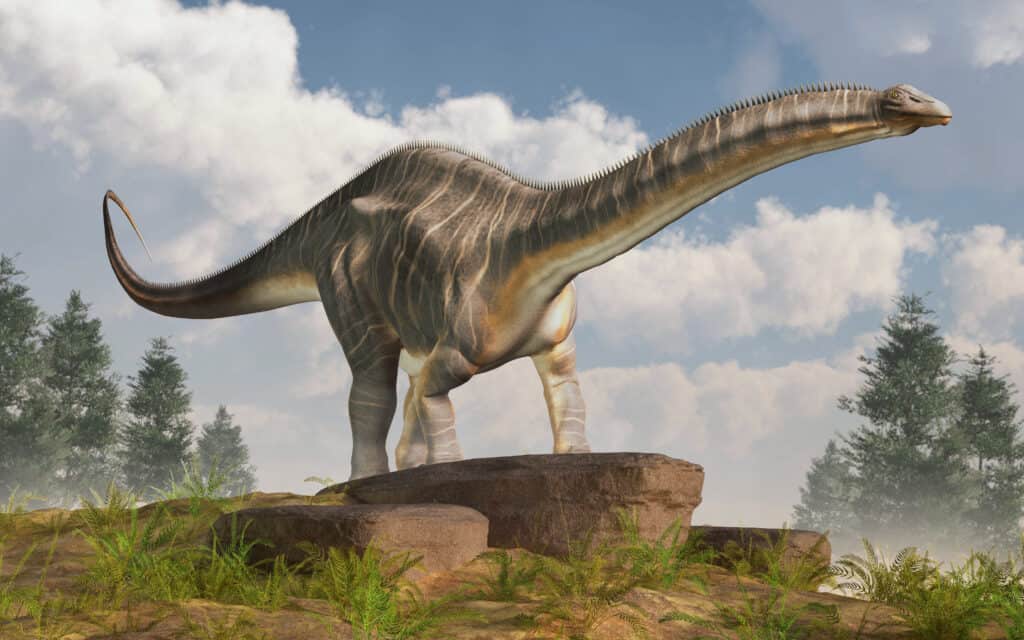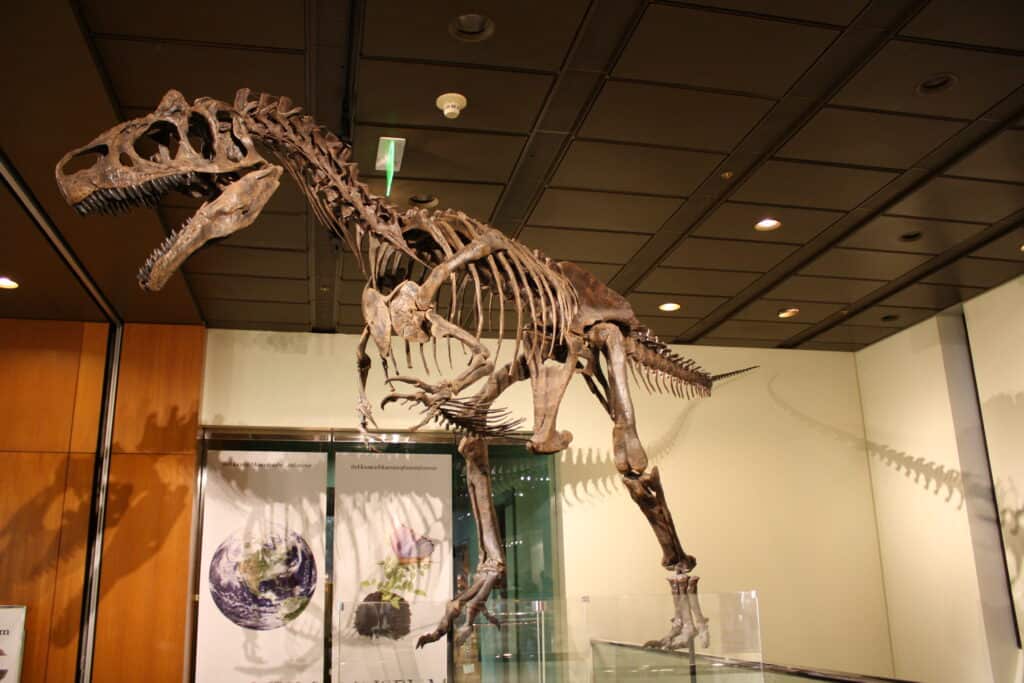Allosaurus
Allosaurus fragilis
Allosaurus is the official state fossil of Utah because of the abundant number of fossils found in the state.
Advertisement
Allosaurus Scientific Classification
- Kingdom
- Animalia
- Phylum
- Chordata
- Family
- Allosauridae
- Genus
- Allosaurus
- Scientific Name
- Allosaurus fragilis
Read our Complete Guide to Classification of Animals.
Allosaurus Conservation Status
Allosaurus Facts
- Prey
- Other dinosaurs
- Main Prey
- Stegosaurus and Apatosaurus
- Fun Fact
- Allosaurus is the official state fossil of Utah because of the abundant number of fossils found in the state.
- Biggest Threat
- Ceratosaurus, Torvosaurus
- Most Distinctive Feature
- Allosaurus had a massive head
- Distinctive Feature
- Allosaurus was a bipedal dinosaur with sharp, serrated, curved teeth
- Habitat
- Semi-arid floodplains with distinct wet and dry seasons.
- Diet
- Carnivore
- Favorite Food
- Type
- Predatory theropod dinosaur
- Special Features
- Allosaurus had a powerful, bulky tail that primarily helped with stability.
- Location
- North America
Allosaurus Physical Characteristics
- Weight
- 4600-5700 pounds
- Height
- 15-16.5 feet
- Length
- 28-32 feet
- Venomous
- No
- Aggression
- Low
View all of the Allosaurus images!
The Allosaurus is a genus of large, theropod dinosaurs that lived during the Jurassic epoch about 155 to 145 million years ago. It was a massive, bipedal dinosaur, which means it walked on its two hind legs and had short arms. It is one of the best-known dinosaurs of all time due to the abundance of fossil remains. As one of the largest carnivores that lived during its time, equipped with rows of large and sharp teeth, Allosaurus was an apex predator, feeding on large herbivores.
Description and Size
The name “Allosaurus” means “different lizard,” alluding to the unique concave vertebrae of this dinosaur, which were different from that of any other dinosaur found before that time.
Allosaurus belonged to a group of dinosaurs known as the Caronosauria. Members of this group are among the largest predatory dinosaurs to have ever lived. In size, the Allosaurus reached an average length of up to 28 feet and was about 15 feet tall. However, Allosaurus fragilis, the largest member of this genus, reached an estimated length of about 32 feet. It had a massive head that measured about 3 feet long. Allosaurus also had a short, thick neck to support the weight of the massive head. Although weight estimates vary, this dinosaur probably weighed between 4,600–5,700 pounds. The smallest species in the genus, Allosaurus europaeus, was roughly 23 feet long and was about 2000 pounds in body mass.
As a flesh-eating dinosaur, Allosaurus had sharp, curved teeth with saw-like edges. It also had sharp claws. It was bipedal, which means it walked on powerful hind legs while the forelimbs were reduced. Each of the Allosaurus‘ three rear toes featured a sharp claw, while its three fore-toes had long, gripping claws. Finally, it had a long, powerful, bulky tail that mainly helped with stability.
The Allosaurus’ teeth measured up to four inches. The teeth grew shorter and curved towards the back of the dinosaur’s mouth for an enhanced savage bite. Fossils of the Allosaurus have been found with some skin impressions preserved. The skin impressions show that this dinosaur had scales on at least some parts of its body. Each of these scales measured about 0.04–0.12 inch in diameter.

had sharp, curved teeth with saw-like edges, sharp claws and was bipedal.
©Cheng Wei/Shutterstock.com
Diet—What Did Allosaurus Eat?
Allosaurus belongs to a group of dinosaurs known as the carnosaurs. Members of this group are known for their predatory behavior and were among the largest predatory dinosaurs to have ever roamed the earth. Allosaurus was an active predator whose prey consisted of large animals. Scientists have evidence for at least one of the main prey of this dinosaur, the Stegosaurus.
It is believed that the Allosaurus targeted herbivores and hunted them actively. However, some experts think it might have been a scavenger as well. This dinosaur hunted in cooperative packs. Taking down enormous prey with their collective efforts. However, they occasionally went on solitary hunts, waiting in ambush behind dense vegetation for their prey.
The Allosaurus could kill healthy, medium-sized sauropods or large sauropods, such as Apatosaurus, that were sick or injured for food. It was an aggressive and fierce predator, as noted by the tooth marks discovered by researchers on the vertebrae of an Apatosaurus. This and several other fossil evidence points to an active predatory lifestyle for this dinosaur.

The
Allosauruscould kill healthy, medium-sized sauropods or large sauropods, such as
Apatosaurus, that were sick or injured for food.
©Daniel Eskridge/Shutterstock.com
Habitat—When and Where Allosaurus Lived
Allosaurus thrived during the late Jurassic epoch about 155 to 145 million years ago. Fossils of this dinosaur are quite abundant in North America’s Morrison Formation. In fact, fossils of this dinosaur account for 70 to 75% of theropod specimens found in this formation.
Scientists have interpreted the nature of this habitat as semi-arid floodplains with distinct wet and dry seasons. Gallery forests of gigantic ferns and other types of trees were present too. However, because of the enormous size of this dinosaur, these creatures likely spent the majority of their lives in open floodplains, only venturing into more heavily wooded areas on occasion. This is due to the fact that forests would have been more difficult for them to navigate.
Threats and Predators
The Allosaurus lived during the Late Jurassic Period; its rival predators during this period were the 39-foot-long Torvosaurus and the horn-nosed Ceratosaurus carnivore. The Ceratosaurus could grow over 19 feet, and there were other carnivores that had similar or smaller sizes to the Allosaurus. However, the battle existed mostly about who gets the prey.
Discoveries and Fossils—Where Allosaurus Was Found
The first Allosaurus bone ever found was described by Joseph Leidy after it was sent to him by Ferdinand Vandeveer Hayden in 1869. However, he erroneously assigned it to the genus Poekilopleuron.
Othniel Charles Marsh gave the name “Allosaurus” to a specimen that was unearthed in 1877. This specimen only provided a small number of dinosaur bone fragments. Marsh and his scientific competitor, Edward Drinker Cope, named many more dinosaur fossils over the years that seemed to be unique. However, as time went on, it was discovered that these fossils were also fossils of the Allosaurus. This caused quite a bit of confusion in the early records of this dinosaur.
H. F. Hubbell, a collector who worked for Edward Cope, found an Allosaurus skeleton in 1879 but apparently did not inform Cope about the completeness of the bones he had found. In 1903, following Hubbell’s death, the specimen was eventually studied and turned out to be one of the most complete theropod skeletons found to date.
Efforts towards the end of the 19th century and the early 20th century were focused on clearing up the confusion caused by the multiple names. Between 1960 and 1965, a team led by James Henry Madsen found more than a thousand dinosaur bones in Utah. At least 46 Allosaurus fragilis individuals were found in the pile.
In 1991, a joint team of researchers from the Rockies Museum and the University of Wyoming Geological Museum discovered a nearly complete Allosaurus fossil. The fossil, which was 95% intact, was nicknamed “Big Al.” In 1996, this same team of researchers discovered “Big Al Two,” which is the best preserved Allosaurus fossil to date.

Big Al II was discovered in the Morrison Formation in 1996 and is the best preserved
Allosaurusfossil to date.
Extinction—When Did Allosaurus Die Out?
Available data indicates that the Allosaurus went into extinction around 144 million years ago. There are different theories about the extinction of this species. Some of the theories suggest that a drought occurred during the period, which led to the death of many dinosaurs, including the Allosaurus.
Similar Animals to the Allosaurus
Similar animals to the Allosaurus include:
- Tyrannosaurus rex (T-Rex) — The T. rex, which means “king of the tyrant lizards,” was a muscular dinosaur that lived in the western part of North America during the Late Cretaceous. The Tyrannosaurus rex is one of the most well-known dinosaurs of all time.
- Ceratosaurus — The Ceratosaurus was one of the apex predators of the Jurassic. It was about six to seven meters long, with a deep jaw and long, blade-like teeth. It lived around the same time as the Allosaurus and was similar in physical appearance as well.
- Neovenator — Neovenator is a genus of theropod dinosaurs that lived in Europe during the Early Cretaceous Period. Measuring about 23 feet in length, Neovenator had a slender build and weighed one metric ton. It belongs to the clade of Allosauroidea, along with the Allosaurus.
Related Animals
View all 192 animals that start with AAllosaurus FAQs (Frequently Asked Questions)
Was the Allosaurus bigger than a T-Rex?
The T-Rex was significantly larger than the Allosaurus. While an adult Allosaurus was between 28 and 39 feet, the average T-Rex adult was about 40-50 feet long.
How did the Allosaurus protect itself?
In protecting itself, the Allosaurus had a powerful skull and jaw, which it could use as a weapon. It also had a long and thick tail that probably helped with stability. The bite force of the Allosaurus was a bit low, but it would have been strong enough to inflict considerable damage on any attacker.
How did the Allosaurus get its name?
The Allosaurus’ name is a combination of two Greek words. The word “Allos” means “strange” or “different,” and “Suros” means “reptile” or “lizard.” The Allosaurus was named “different Lizard” because its vertebrae were distinctly different from that of other dinosaurs known at the time.
When was the Allosaurus alive?
Allosaurus lived during the Jurassic Period about 155 to 145 million years ago.
How big was the Allosaurus?
Allosaurus was an average of 28 feet in length. However, Allosaurus fragilis, the largest member of this genus, was up to 32 feet. it weighed between 4600 and 5700 pounds.
Thank you for reading! Have some feedback for us? Contact the AZ Animals editorial team.
Sources
- Enchanted Learning / Accessed November 12, 2022
- Micro B Life / Accessed November 12, 2022
- McGill / Accessed November 12, 2022
- Brittanica / Accessed November 12, 2022
- Animals Network / Accessed November 12, 2022















